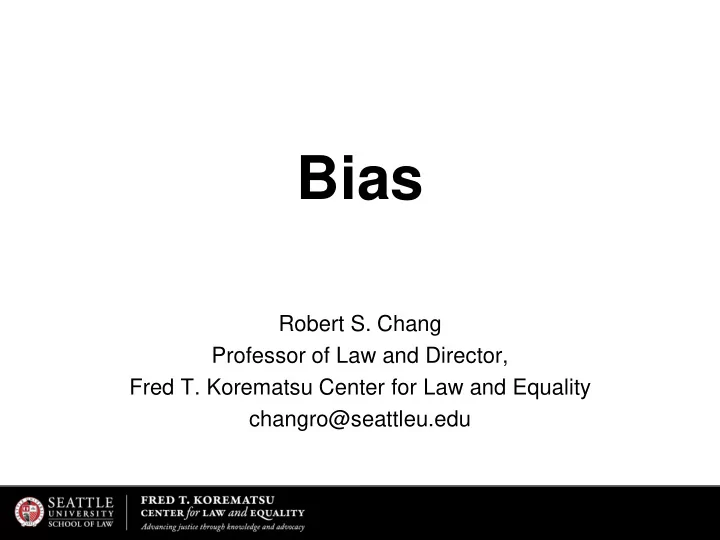

Bias Robert S. Chang Professor of Law and Director, Fred T. Korematsu Center for Law and Equality changro@seattleu.edu
So far . . . • History/context • Disproportionalities throughout CJS • Proffered causes • Crime commission • Neutral policies with disparate outcomes • Bias
Attitudes and Stereotypes Conscious/explicit Unconscious/implicit • Admission • Linguistic • Survey • Micro-facial movements • fMRI • Cardiovascular • IAT • Decisions/behaviors
Attitudes and Stereotypes (cont.) Expressed racial attitudes Implicit racial biases (white respondents) (all respondents) Support law • Pervasive against • Large in magnitude Black/White intermarriage “[W]e are not, on average 1964 60% 2002 10% or generally, cognitively colorblind” But in 2002, 24% still opposed intermarriage between Blacks and Whites
Attitudes and Stereotypes (cont.) Expressed racial attitudes IAT stereotypes (all respondents) (white respondents) Causes of Black inequality 72% associated MALE Blacks Blacks lack have no with SCIENCE and ability motivation FEMALE with HUMANITIES 1977 27% 66% 2006 7% 52% -------------- Blacks are treated unfairly American = White by police Undocumented = Latino 1997 36% Foreign = Asian 2004 35%
Connecting bias to behaviors and outcomes Conscious/explicit Unconscious/implicit • Bias • Bias • Problem of proof • Problem of proof • Concealed motives • Behavior • Behavior • Outcome • Outcome
Outcomes and Problems of Proof Med-mal case, Eastern Experiment involving WA Disabled Person • Bias • Bias • Behavior • Behavior • “Mr. Miyagi”; “Mr. • Seating choice Kamikaze”; “Pearl Harbor Day” • Outcome • Outcome? • Disabled person watching movie alone, more often Turner v. Stime, 153 Wash. App. than not, if movie choice 581 (Wash. App. Div. 3 2009) given
Price Waterhouse v. Hopkins (specific) Conscious/explicit Unconscious/implicit • gendered comments • “unwitting or ingrained bias is no less injurious or worthy of eradication than blatant or calculated discrimination . . . the fact that some or all of the partners at Price Waterhouse may have been unaware of that motivation, even within themselves, neither alters the fact of its existence nor excuses it” • 825 F.2d 458 (D.C. Cir. 1987)
White- and Black-sounding Names (aggregate) Conscious/explicit Unconscious/implicit • Bias • Bias • Proof? • Proof? • Behavior • Behavior • Callback decision • Callback decision “White” candidates received 50% more callbacks than “Black” candidates Lower- skilled “White” candidates got many more callbacks than highly skilled “Black” candidates High quality “Blacks” received same calls as average “Blacks”
Traffic Stops Conscious/explicit Unconscious/implicit • Bias? • Bias? • Behavior • Behavior • Decision to search/citation • Decision to search/citation
Traffic stops, WSP Nov. 1, 2005-Sept. 30, 2006 18 year old male, daytime, interstate, non-Latino All stops White male officer, one non-serious violation Predicted search rate Low discretion High discretion DUI, search Native American 3.1% 1.6% 91% Latino 1.1% .7% 85.9% Black 1.2% .6% 84.9% Non-Latino White .8% .4% 81.7% Asian/PI .6% .25% 77.7% East Indian .1% .1% 82.4% Loveritch et al., No evidence of intentional discrimination
Effects of Bias (explicit, implicit, or in combination) • Initial Stereotypes and Associations • Suspicion, Investigation and Interrogation • Arresting and Charging • Pretrial detention/bail • Eyewitness Testimony • Conviction and Sentencing
Limits of Current Antidiscrimination Law Intentional discrimination Disparate impact Perpetrator who has Actor Discriminatory intent which Disparate impact on a brings about protected group Action that causes Insufficiently justified policy/practice Discriminatory outcome Limited applicability
Interventions Conscious/explicit Unconscious/implicit • Accountability • Accountability • Education • Education • Exposure • Exposure • Other • Other
At the end of the day • Disproportionalities throughout CJS • Crime commission rates do not account fully for these disproportionalities • Facially neutral policies + bias at work • Race matters in ways that are not fair, that produce racial disparities, that do not advance legitimate public safety objectives, and which undermines confidence in our legal system
Recommend
More recommend